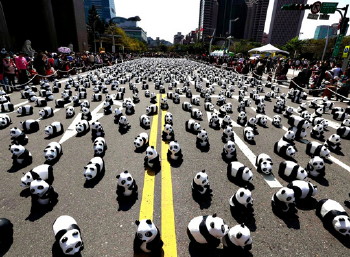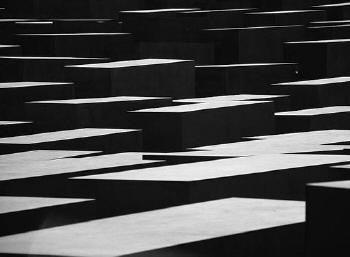Artist:
Stephen Cox
Title:
Water Feature
Year:
1991
Adress:
Exchange Square
Universal
The impact of natural elements (stone, water) as Water Feature Stephen Cox is strong and by pointing to words like a comprehensive universal system, continuity, human nature, responsibility, tradition and hope.
By Theo, www.artatsite.com
Compared with other artworks
In the Garden of Exils Daniel Libeskind (Berlin, picture 1, more information) the olive-trees refer to tradition, trust, hope and future. The olives are standing in a cube and thus refers to the essential role of the substrate, the base, the tradition. The slope refers to a continuous and positive development, in my opinion. Even when Libeskind makes use of comparable aesthetic elements (cubes, a non-flat surface), he added thereto essential elements (olive trees) and so the meaning of the work is entirely different than the artwork by Eisenmann.
The use of massiveness has a major impact in 1600 Pandas by Paolo Grangeon (Hong Kong, picture 2, more information) by the friendly looking pandas who activate to immediate global action to protect nature.
Massiveness can also have an absolute nature. The question in The Wolves Are Coming by Liu Ruowang (Beijing, picture 3, more information) whether the lone person can keep standing up against the wolves. The artis can refer to different matters. It is at least something violent which man fears. This can be anything; natural disasters, other people, the government, big compagnies, etc. This work brings in a general topic with a strong emotion but gives no direction for a solution.
Denkmal für die ermordeten Juden Europas by Peter Eisenman (Berlin, picture 4, more information) is a masterpiece and is pointing effectively to major historical events and meanings, for Germans and also for mankind. A cube is a minimal element which refers to essential values, like peace and humanity. Scrolling between the blocks can bring this desire. A rectangle form refers to more specific symbols. I think in this case of a tombstone. It focuses strongly on the past, but is less meaningful to the present and the future. It recalls feelings from the past but provides less comfort for the future.
By Theo, www.artatsite.com

Picture 1
www.vicinitee.com
In designing this water feature, sculpture Stephen Cox (see also, Ganapathi & Devi) worked in conjunction with Chicago_based architects Skidmore, Owings and Merrill, who were responsible for the entire eastern side of Broadgate, including Bishopsgate, Broadwalk House and Exchange House. The Japanese_inspired water sculpture brings a marvellously tranquil piece of landscape art to an otherwise busy corner of Broadgate.
www.wikipedia.org:
Cox studeerde van 1966 tot 1968 aan de Central School of Art and Design in Londen. Hij is werkzaam als steenbeeldhouwer en werkte gedurende jaren in groeves in Italië (met Etruskisch travertijn en Bardigliomarmer); in Egypte (1988-1989: beeldhouwwerk voor het nieuwe Caïro Opera House met rode porfier uit de historische groeve Mons Porpyritis in de Arabische Woestijn ten oosten van de Nijl), maar toch vooral in India (waar hij vanaf 1985 in Mahabalipuram was als voorbereiding op de Triënnale van 1986 in New Delhi met graniet uit Kanchipuram). In India maakte hij onder andere het werk Honey Lingam (1987-2004) en in Egypte Dreadnought, Problems of History (search for the hidden stone) (1990-2004).
In 1982 vertegenwoordigde hij met onder anderen Antony Gormley, Anish Kapoor en Bill Woodrow Engeland met de expositie Aperto 82 tijdens de Biënnale van Venetië en in 1986 nam hij deel aan de Sixth Indian Triënnale in New Delhi. De expositie Mappa Mundi[1] van 2004 in Burford House bij Ludlow (Shropshire) was geheel aan het werk van Stephen Cox gewijd.
De kunstenaar woont en werkt in Shropshire, Cleehill.
The impact of natural elements (stone, water) as Water Feature Stephen Cox is strong and by pointing to words like a comprehensive universal system, continuity, human nature, responsibility, tradition and hope.
By Theo, www.artatsite.com
Compared with other artworks
In the Garden of Exils Daniel Libeskind (Berlin, picture 1, more information) the olive-trees refer to tradition, trust, hope and future. The olives are standing in a cube and thus refers to the essential role of the substrate, the base, the tradition. The slope refers to a continuous and positive development, in my opinion. Even when Libeskind makes use of comparable aesthetic elements (cubes, a non-flat surface), he added thereto essential elements (olive trees) and so the meaning of the work is entirely different than the artwork by Eisenmann.
The use of massiveness has a major impact in 1600 Pandas by Paolo Grangeon (Hong Kong, picture 2, more information) by the friendly looking pandas who activate to immediate global action to protect nature.
Massiveness can also have an absolute nature. The question in The Wolves Are Coming by Liu Ruowang (Beijing, picture 3, more information) whether the lone person can keep standing up against the wolves. The artis can refer to different matters. It is at least something violent which man fears. This can be anything; natural disasters, other people, the government, big compagnies, etc. This work brings in a general topic with a strong emotion but gives no direction for a solution.
Denkmal für die ermordeten Juden Europas by Peter Eisenman (Berlin, picture 4, more information) is a masterpiece and is pointing effectively to major historical events and meanings, for Germans and also for mankind. A cube is a minimal element which refers to essential values, like peace and humanity. Scrolling between the blocks can bring this desire. A rectangle form refers to more specific symbols. I think in this case of a tombstone. It focuses strongly on the past, but is less meaningful to the present and the future. It recalls feelings from the past but provides less comfort for the future.
By Theo, www.artatsite.com

Picture 1
In designing this water feature, sculpture Stephen Cox (see also, Ganapathi & Devi) worked in conjunction with Chicago_based architects Skidmore, Owings and Merrill, who were responsible for the entire eastern side of Broadgate, including Bishopsgate, Broadwalk House and Exchange House. The Japanese_inspired water sculpture brings a marvellously tranquil piece of landscape art to an otherwise busy corner of Broadgate.
www.wikipedia.org:
Cox studeerde van 1966 tot 1968 aan de Central School of Art and Design in Londen. Hij is werkzaam als steenbeeldhouwer en werkte gedurende jaren in groeves in Italië (met Etruskisch travertijn en Bardigliomarmer); in Egypte (1988-1989: beeldhouwwerk voor het nieuwe Caïro Opera House met rode porfier uit de historische groeve Mons Porpyritis in de Arabische Woestijn ten oosten van de Nijl), maar toch vooral in India (waar hij vanaf 1985 in Mahabalipuram was als voorbereiding op de Triënnale van 1986 in New Delhi met graniet uit Kanchipuram). In India maakte hij onder andere het werk Honey Lingam (1987-2004) en in Egypte Dreadnought, Problems of History (search for the hidden stone) (1990-2004).
In 1982 vertegenwoordigde hij met onder anderen Antony Gormley, Anish Kapoor en Bill Woodrow Engeland met de expositie Aperto 82 tijdens de Biënnale van Venetië en in 1986 nam hij deel aan de Sixth Indian Triënnale in New Delhi. De expositie Mappa Mundi[1] van 2004 in Burford House bij Ludlow (Shropshire) was geheel aan het werk van Stephen Cox gewijd.
De kunstenaar woont en werkt in Shropshire, Cleehill.






